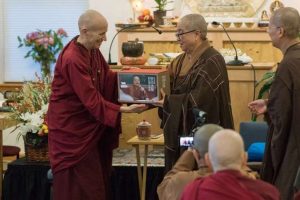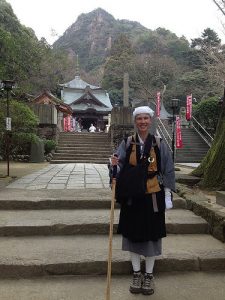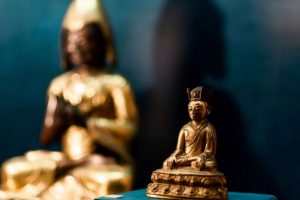
Shakaymuni Buddha is held up as the paragon of enlightened thinking. This may lead us to overlook that he, too, needed to be educated about ways in which his worldview was limited and conditioned by his culture, particularly around gender. The decisions he made as a leader of a spiritual community were not infallible. Compared with other Indian religions of the time, the Buddha’s view on the spiritual capacity of women was revolutionary. He affirmed that women are as capable of enlightenment as men. However, he made that acknowledgment only after some skillful confrontation on the part of his beloved attendant, Ananda.
The way the story goes, Mahapajapati Gotami, who was the Buddha’s aunt as well as his stepmother, approached the Buddha to request ordination for hundreds of women who were dedicated to the practice of awakening, including herself. The Buddha refused. She asked him two more times. Each time he refused.
Mahapajapati was a woman of strength and perseverance. She and her sangha of women went ahead and shaved their heads and wore patchwork robes, just as the monks did, and set off on a long journey to find the Buddha. When they finally arrived at the place where he and his monks had stopped, they were utterly exhausted. As she sat at the gates of the monastery, Mahapajapati broke down in tears. Ananda saw her and asked what had happened. When she told him the story of requesting ordination from the Buddha only to be refused, Ananda promised that he, too, would ask on behalf of the women. He kept his word but received the same answer from the Buddha.
Ananda then pushed back and asked the Buddha if women were able to attain nirvana. When the Buddha said yes, Ananda encouraged him to ordain the women and admit them into the monastic sangha. Finally, the Buddha assented, but only after stipulating eight rules that continued to reinforce women’s subservience to men in the sangha.
I share this story because it reminds us that spiritual leaders and communities are just as subject to being complicit in systemic oppression—in this case, sexism—as any other group. There is no free pass just because one is a spiritual teacher.
Some scholars theorize that the Buddha took this stance in order to protect the larger sangha—out of concern that he would alienate supporters—as well as the women, who would be subject to ridicule and violence. Whatever his intention, Shakyamuni Buddha’s initial rejections were not affirming nor empowering to the women in the sangha, and his conditioning of the decision to ordain them on the Eight Garudhammas set in motion a chain of karma that continues to this day.
That story happened more than 2,500 years ago. While progress toward gender equity has happened on a number of fronts in Buddhist communities and society at large, the devastating effects of sexism continue into our times.
As Venerable Lekshe Tsomo noted in her 2015 article “Attention Buddhist Women! It’s Time to Wake Up!” the majority of the world’s work is done by women and yet their work is not valued equally to men. In the United States, three million more women than men were living below the poverty line in 2022.* Globally, 247 million women 15 years old and older live on less than US$1.90 per day, compared to 236 million men.**
Lekshe Tsomo’s essay is a call to women to step up to awakening in a world that needs our voice, our presence, and our skillful actions. This is also a call for men to awaken and to take an active role in exploring how sexism may be manifesting in our communities, often unconsciously.
I also want to lift up the words of Satya Robyn, a psychotherapist and Buddhist teacher who founded the Bright Earth Temple in Malvern, in the United Kingdom, with her spouse Kaspa (they/them):
At the current rate of change, it will take 131 years for women to earn the same as men.
This bare fact points towards the lived experience of being a woman.
The times the man in authority or the man serving speaks to my spouse and not to me. The regular underestimation of my intellect and of my resilience. The patronising tone. The valuing of ‘male’ structures and ways of being over ‘feminine’ ones.
It’s hard to REALLY know how it is to be a woman in this world unless you live as one. And the patriarchy, like all oppressive systems, doesn’t serve any of us. . . . Let’s take a hammer to it—all of us—and break it into pieces. Let’s recycle it into the earth and grow something new and wild and beautiful.
I love my siblings of all genders. We are better than this. We will keep rising up.
(Substack, adapted with permission)
I appreciate Satya’s words because they illuminate that what’s being called for is not only a change in numbers and statistics, but a qualitative change in what our culture defines as important. We can ask why work that women often do related to caring and compassion is valued so much less than other kinds of labor. We can look in our own sanghas and note how many if any leadership positions are held by women. If there is an absence, can we come to a deeper understanding of why this may be and explore ways to rectify it? Does our sangha value emotional expression and connection as much as efficiency? Do we recognize process as equally important as product? And we can recognize the intersectionality of oppression to ensure that we are lifting up the voices of people of color, those who identify as transgendered, those with fewer economic resources, and those with different physical and psychological abilities.
In these troubled and complicated times, our humanity needs the diversity of our gifts to come forth, the gifts that come from different ways of seeing and being in the world. To me, “healing” means bringing things previously fragmented back into wholeness. I am remembering a line from “Bread and Roses,” a poem by a man, James Oppenheim, set to music by a woman, Mimi Farina: “The rising of the women means the rising of us all.”
How can we, like Mahapajapati, have faith in our buddha-nature and speak our truth to power . . . and draw on power-with rather than power-over? How can we, like Ananda, keep our eyes open to injustice and use the privilege of our positions to advocate for fairness? How can we, like the Buddha, be willing to have others reflect to us our own blind spots and be open to change? How can we all awaken together?
* Number of people living below the poverty line in the United States from 1990 to 2022, by gender (Statista)
** Gender poverty gaps worldwide in 2020 and 2021 (with a forecast to 2030), by gender (Statista)
See more
Attention Buddhist Women! It’s Time to Wake Up!: Karma Lekshe Tsomo (Upaya Zen Center)
Satya Robyn: International Women’s Day (Substack)
Related features from BDG
Book Review: Yin Mountain: The Immortal Poetry of Three Daoist Women
Buddhistdoor View: Experiencing the Phase Shift – Women in Buddhism Today
Buddhist Women’s Orders Return to their Ancestral Motherlands: First International Theravada Bhikkhuni Ordination in Bangladesh
Anula Stupa Relics Unearthed: New Excavations Illuminate the Women’s Order in Sri Lanka and Around the World
Women in Shugendo: Supporters, Leaders, or Both? Part 3
Related news reports from BDG
International Women’s Meditation Center Foundation Announces Outstanding Buddhist Women for 2024
Jetsunma Tenzin Palmo among BBC’s 100 Influential Women of 2023
International Women’s Meditation Center Foundation Presents 16 Outstanding Women in Buddhism Awards
Young Buddhist Association of Indonesia Holds Interfaith Dialogue on Women and Spirituality
BBC Names Tzu Chi Founder, Dharma Master Cheng Yen, among 2022’s 100 Most Influential Women













Thank you for this subtle article.
I believe the difference between the Buddha being made aware of his sexism and our being made aware of our sexism (or racism, or heterosexism, or ablism, or the like) lies in our response, not our surprise. Even the Buddha must have been surprised by a new awareness of this sexism he had inherited. But we can read this story as implying he dropped that sexism immediately. That is the key. We are all products of our cultural contexts. Now what?
Well the Buddha dropped it after several different messages were given to him ; ) But yes, after THAT he turned the corner. Though it’s unfortunate he still attached special conditions to the ordination of women, over and above what male monks went through (and that continues to this day in many Asian Buddhist sanghas).
But yes, thank you Franz for raising that distinction. The main point is that ALL of us are subject to the assumptions that get handed down to us, and the key is being committed to be in a continual waking up process.
Thank you for this article Maia! I am a lay practitioner who has left a more formal practice to focus on my 2.5-year-old and newborn coming any day now. I struggle with a pull of wanting to be in sangha and the reality that my practice is my home life now. In some ways I feel my home practice is written off as less valid than a formal sitting practice.
Something I’ve always struggled with is not feeling met or seen by many of my teachers. There’s often a glorification of silence and for many folks conditioned as women, we shouldn’t be silent! Instead we should be encouraged to speak and to say something! While I feel deep appreciation for all I’ve learned from sitting in the American Zen context, sometimes I feel like I’m sitting in a rigid patriarchy that doesn’t meet the needs of folks conditioned as women, people of color, or people who don’t identify as cisgender.
Hi Kelsey, I noticed you said that you feel in some ways your home practice is written off because it is less formal. I was conducting some research on Buddhism online and came across your comment and I think you may benefit on something I had found. I think you should read an article on this website titled “Zen in the Mettaverse: How a 400-Year-Old Buddhist Temple is Evolving in Response to Modern Japanese Suffering” which talks a virtual temple created by Rev. Fujio which mirrors a real temple exactly. Avatars can even sit on the meditation cushions and experience the temple from the comfort of their own home, whilst conducting meditation formally in a formal setting (just virtually formal). The article noted that it was accessible via the browser-based Spatial.io app. I just thought this might make you feel as though your practice isn’t written off if conducted in a simulated formal setting with a real Buddhist priest.
Hi Kelsey,
Apologies for the delay in responding, just noticed your comment now.
I hear you about that struggle to feel seen and recognized as a lay practitioner, and especially as a parent (which I am not). Also I appreciate your observation that women get so much social conditioning about censoring ourselves and our voices. Audre Lorde wrote a lot about this and I think of one of her quotes — “When we speak we are afraid our words will not be heard or welcomed. But when we are silent, we are still afraid. So it is better to speak.”
I do believe there is a way in which we can discover and reclaim the healing power of silence through practice, but the oppressive uses of it also have to be acknowledged. Thank you for bringing this up.